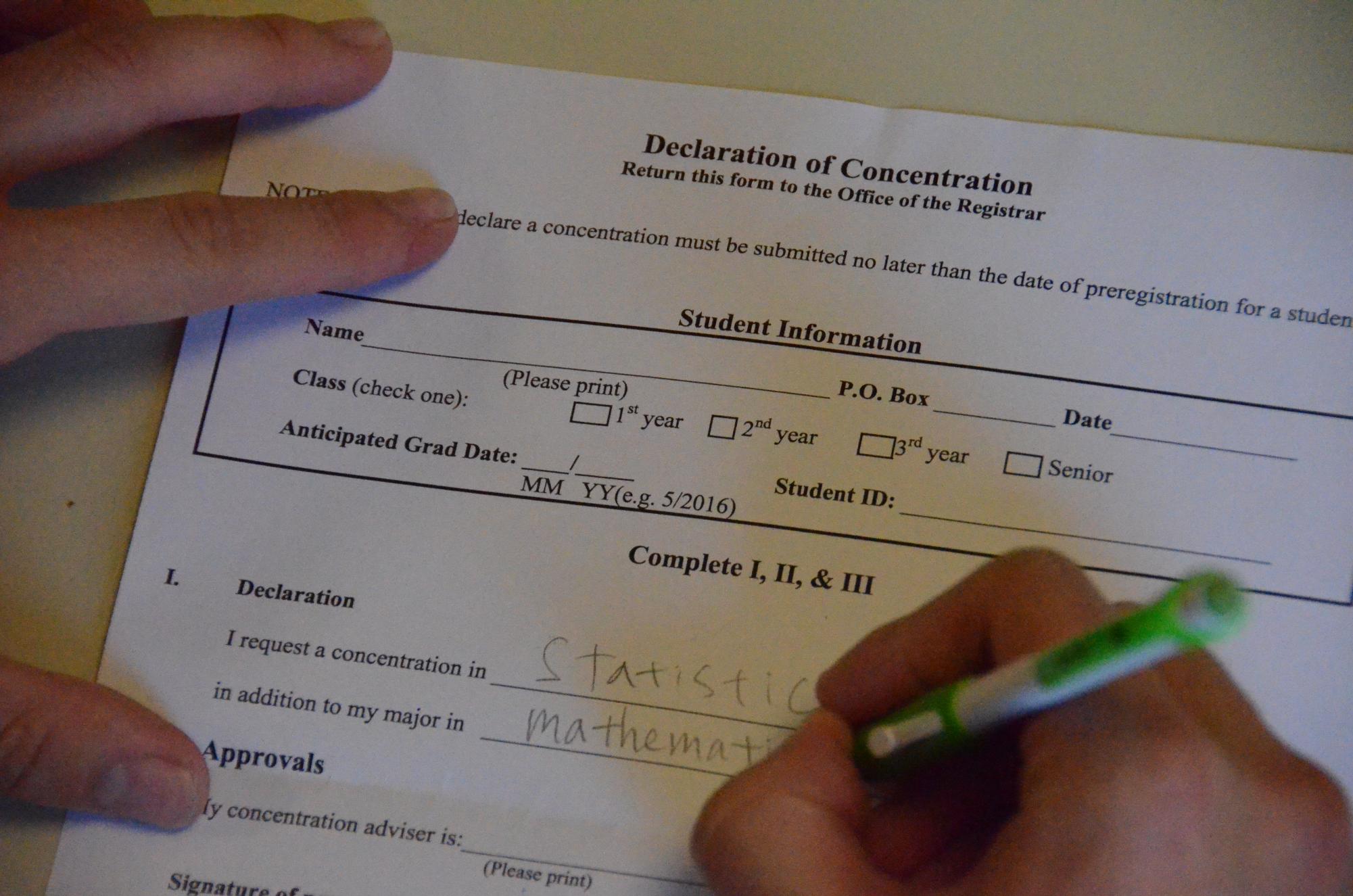Some concentration chairs may now be compensated for their duties, contingent upon a faculty vote on several recommendations posed by the Executive Council.
The recommendations, found in the Faculty Meeting notes from April 15, will be voted on by faculty on May 6. They would allow the Executive Council to implement new policy on concentration compensation, establishment, hiring and other issues that were identified by the Council. If passed, these recommendations would be implemented in the 2024-25 academic year.
This recommendation comes in the wake of an increase in students declaring concentrations — 33% of this year’s graduating class has declared a concentration, compared to just 19% of the class of 2015.
Tim Arner, associate dean of curriculum and academic programs and professor in the English department, said that questions about rules surrounding concentrations sparked an initial review.
“We were thinking about, well, what are the rules governing how someone joins a concentration, how they officially leave a concentration,” Arner said. “How do we know that a concentration is fully staffed? What do we do when students aren't interested in the concentration anymore or if we want to create a new concentration?”
Arner worked with Cynthia Hansen, previous associate dean of the College, to brainstorm initial issues surrounding concentrations in spring 2023. “She [Hansen] and I did the initial brainstorming to think through some of those issues, and then I've spoken to the registrar about it and eventually I went to Executive Council … then they kind of moved things forward from there,” Arner said.
The recommendation calls for the Dean to “immediately provide appropriate compensation” to the chairs of the Education Studies, Environmental Studies, Linguistics and Neuroscience concentrations “commensurate with the compensation provided to the Statistics concentration.” It also calls for the Dean to work with the Film and Media Studies, Global Development Studies and Policy Studies chairs to provide “appropriate compensation reflecting their workload.”
The recommendation cited five criteria — advising responsibilities, enrollment, lab courses, capstone experiences and SEPCs — as integral to understanding the differing workload among concentration chairs.
“I think it's important to recognize that not all concentrations operate the same,” Arner said. “There's a very big difference between how different concentrations operate and so we want to recognize that difference and then treat the concentrations appropriately.”
Deborah Michaels, chair of the Education Studies concentration, said she was told to expect a higher initial workload because the Education Studies concentration is new this year, and there were several students interested in talking about whether they would be able to obtain a concentration in the time they had left. “It was probably sometimes three half days of my work week because I was getting the students who wanted a concentration but it hadn't existed,” Michaels said. She noted that the Education Studies concentration is now larger in enrollment than some majors.
“I did see it as an inequity that the labor that I and other concentration chairs have put into that administrative work wasn't even considered for some kind of compensation or course release before when it's automatic for all department chairs,” Michaels said.
“I'm sure that it is somewhat more work than some concentration[s] where there are far fewer students,” said Mark Levandoski, chair of the Neuroscience concentration. “Is that a problem? I don't really know. I'm a believer in that things have a way of evening themselves out, but I've also been here long enough to know that there are plenty of people that take on the responsibilities because if for no other reason, they just know someone needs to.”
Levandoski stated that he does not believe his workload is high enough to warrant compensation, noting that he speaks for himself and not his colleagues.
“The real problem is, the more we say that there should be compensation for various things, the more it takes us out of the classroom,” Levandoski said. “For any curricular group, if you are relieving someone from teaching something … you have to be able to try to find someone to staff these courses. So I'm a little bit in the other direction to say, if I could manage all this and then still be available to teach the courses and so on, then that's where I'd rather be.”
Other issues accounted for in the recommendation included a lack of clear policy surrounding establishing new concentrations. Michaels said that the process of establishing the Education Studies concentration included finding faculty on campus that were willing to serve as chair eventually, writing proposals and creating a curriculum.
“I can say that I did find bringing the proposal through several different committees was, for repeated viewing at times, felt like a lot of bureaucracy, but I know that that's how a lot of institutions work,” Michaels said. “It'd be lovely if they streamlined that, but I don't know if that's on the table.”
Arner noted that the labor required to establish a concentration is currently not compensated. “It can take a number of months or even longer to really put a concentration together,” Arner said. “I don't know that we have a good way of recognizing that work, but I think it's a really good point that that is significant labor for people who want to start a concentration, and so we should really think about how that fits into their other duties.”
The recommendation also included proposed guidelines surrounding hiring faculty into concentrations. “A person who was hired as a faculty member here has to have a departmental home,” Levandoski said. “That doesn't necessarily always jive with the idea that someone might be very interdisciplinary in their teaching scholarship, perhaps, so much so that no actual department that we have fits them.”
Currently, the only two concentrations housed within their own departments are statistics and Education Studies.
Arner said that he was glad the College was taking a look at this issue. “I think this is a really important issue and something that is kind of long overdue,” Arner said. “It takes a lot of time because there's so many different moving pieces that are involved in creating a concentration and maintaining a concentration.”
Editor's Note: Information was added to the statement about the education studies concentration chair expecting more workload next year to clarify that this will be partly due to several students wanting to discuss whether or not they will be able to obtain the concentration.







